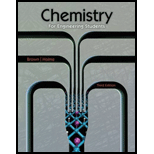
Concept explainers
(a)
Interpretation: The expected equation of decay.
Concept Introduction: With the help of Band of Stability graph, we can calculate the value of N/Z ratio and hence determine the type of emission:-
1. Isotopes that lie below or towards the right of the band of stability have excess of neutrons so they emit beta particles to attain stability.
2. Isotopes that lie above or to the left of the band of stability have more protons so they emit positron or electron capture occurs so the extra neutron increases stability.
3. Heavy nuclei emit alpha particles to attain stability.
(b)
Interpretation: The expected equation of decay
Concept Introduction: With the help of Band of Stability graph, we can calculate the value of N/Z ratio and hence determine the type of emission:-
1. Isotopes that lie below or towards the right of the band of stability have excess of neutrons so they emit beta particles to attain stability.
2. Isotopes that lie above or to the left of the band of stability have more protons so they emit positron or electron capture occurs so the extra neutron increases stability.
3. Heavy nuclei emit alpha particles to attain stability.
(c)
Interpretation: The expected equation of decay.
Concept Introduction: Concept Introduction: With the help of Band of Stability graph, we can calculate the value of N/Z ratio and hence determine the type of emission:-
1. Isotopes that lie below or towards the right of the band of stability have excess of neutrons so they emit beta particles to attain stability.
2. Isotopes that lie above or to the left of the band of stability have more protons so they emit positron or electron capture occurs so the extra neutron increases stability.
3. Heavy nuclei emit alpha particles to attain stability.
Want to see the full answer?
Check out a sample textbook solution
Chapter 14 Solutions
Chemistry for Engineering Students
 Chemistry for Engineering StudentsChemistryISBN:9781285199023Author:Lawrence S. Brown, Tom HolmePublisher:Cengage Learning
Chemistry for Engineering StudentsChemistryISBN:9781285199023Author:Lawrence S. Brown, Tom HolmePublisher:Cengage Learning Chemistry for Engineering StudentsChemistryISBN:9781337398909Author:Lawrence S. Brown, Tom HolmePublisher:Cengage Learning
Chemistry for Engineering StudentsChemistryISBN:9781337398909Author:Lawrence S. Brown, Tom HolmePublisher:Cengage Learning Chemistry by OpenStax (2015-05-04)ChemistryISBN:9781938168390Author:Klaus Theopold, Richard H Langley, Paul Flowers, William R. Robinson, Mark BlaserPublisher:OpenStax
Chemistry by OpenStax (2015-05-04)ChemistryISBN:9781938168390Author:Klaus Theopold, Richard H Langley, Paul Flowers, William R. Robinson, Mark BlaserPublisher:OpenStax Chemistry: Principles and PracticeChemistryISBN:9780534420123Author:Daniel L. Reger, Scott R. Goode, David W. Ball, Edward MercerPublisher:Cengage Learning
Chemistry: Principles and PracticeChemistryISBN:9780534420123Author:Daniel L. Reger, Scott R. Goode, David W. Ball, Edward MercerPublisher:Cengage Learning Chemistry & Chemical ReactivityChemistryISBN:9781133949640Author:John C. Kotz, Paul M. Treichel, John Townsend, David TreichelPublisher:Cengage Learning
Chemistry & Chemical ReactivityChemistryISBN:9781133949640Author:John C. Kotz, Paul M. Treichel, John Townsend, David TreichelPublisher:Cengage Learning General Chemistry - Standalone book (MindTap Cour...ChemistryISBN:9781305580343Author:Steven D. Gammon, Ebbing, Darrell Ebbing, Steven D., Darrell; Gammon, Darrell Ebbing; Steven D. Gammon, Darrell D.; Gammon, Ebbing; Steven D. Gammon; DarrellPublisher:Cengage Learning
General Chemistry - Standalone book (MindTap Cour...ChemistryISBN:9781305580343Author:Steven D. Gammon, Ebbing, Darrell Ebbing, Steven D., Darrell; Gammon, Darrell Ebbing; Steven D. Gammon, Darrell D.; Gammon, Ebbing; Steven D. Gammon; DarrellPublisher:Cengage Learning





